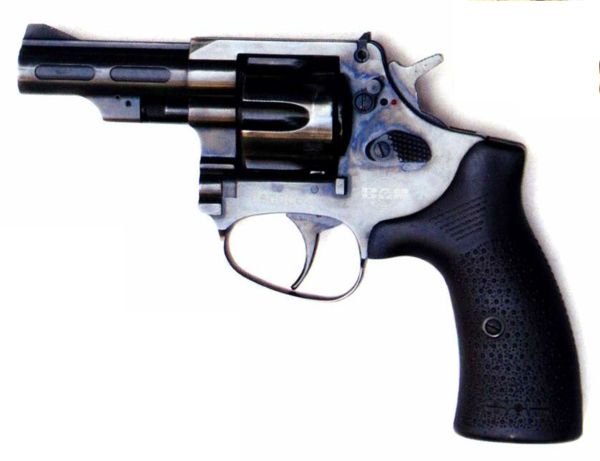 |
| (Source) |
World Guns has a photo and greater description of the weapon:
 |
| (World Guns) |
The revolver is unusual in that it also has a manual safety, which you can see above the cylinder release. Otherwise, it appears to be a standard double action revolver with a swing-out cylinder.
Here is a clearer photo of the holster's retention strap and the speed loaders:
 |
| (Source) |
The Chinese have taken a very conservative approach in arming their police. Although the round is proprietary, as noted, it is similar to the .38 S&W--a round widely used by British police forces throughout its colonies prior to and during WWII; and still, as I understand it, used by police in India. So, essentially they are being armed just as their British predecessors in the Shanghai police of 80-90 years ago would have been armed. The primary difference is the inclusion of rubber bullets.
Positive points: A revolver is easy to maintain and train to use. In single-action, it can be very accurate. Although the ammunition here is woefully underpowered by American standards, assuming it is comparable to the .38 S&W, recoil would be minimal. Also, in modern revolvers, the .38 S&W can be loaded up to be almost as powerful as the .38 Special. I would expect that the same could be done with the Chinese 9 mm round here if it proved necessary.
As the photo immediately above shows, the officers have two speed loaders. Presumably the red speed loaders carry the lethal ammunition. In addition to the color difference, the knob to release the bullets is shaped differently between the loaders, which will be helpful for reloading by feel.
I've always questioned whether American police needed to shift from revolvers to auto-loaders, so I'm not someone to view the limited rounds and slower reload as necessarily a disadvantage--particularly if they are going to be patrolling in pairs. The shift in the U.S. from revolvers to semi-auto pistols is, to me, one of the major points on the road to the current militarization of the police.
Negative points: There are some negative points I see with the Chinese set up. The move to arming the police is partly in response to recent mass knife attacks and a growing number of armed criminals. However, some of the equipment seems specifically designed to slow down access to the weapon. As you can see, the holster does not use a "thumb-break" retention strap (which allows you to establish a grip on the gun and merely use the thumb to release the strap), but must be disengaged with the hand, then a grip established on the weapon, and then the revolver pulled free. In all, a slower, more awkward system--particularly if the officer is attacked and needs to quickly draw his weapon.
The inclusion of a safety seems to an unnecessary complication. It isn't really needed with a revolver, adds additional parts to what is already a complicated mechanism, and, again, slows down the officer's ability to quickly draw and fire his weapon if necessary. I would note in this case that the safety lever is small and probably hard to operate under stress.
The hammer is narrow, which makes it harder to manually cock--or decock. The trigger also does not look particularly comfortable.
From what I can see of the rear sights, they look small and dark--i.e., hard to see. And using a pin to mount the rear sight doesn't look particularly sturdy.
Update (5/8/2014): Just wanted to thank Grant Cunningham for his link.
Update (5/12/2014): The Firearms Blog has cross-sectional photos of the Chinese bullets, and further description of the round. They state, in part:
The jacketed bullet is interesting. It has a copper jacket covering a block of high-density polyethylene at the front and a lead disc at the base. The lead base looks like it makes up around 40% of the total volume of the bullet.I also had a friend point out that the safety, because of its location, is probably a simple hammer block. This suggests that the trigger could be pulled, working the mechanism, without a round being fired.
According to the specifications also published in Chinese forums, the bullets weighs 123 gr and has a muzzle velocity of 721 fps. This works out to a muzzle energy of just 142 ft.lbs. This is the same muzzle energy as a high velocity .22 LR and less than a hyper velocity .22 LR. Penetration would be a lot worse than a .22 LR owing to the larger caliber and expansion of the polymer components.
Update (7/22/2015): The Firearms Blog has posted some video and comments from a Chinese reader about the cartridge.
I'll tell you one thing, they are so restrictive and tiranyc they fear the police can revolt themselves, like Britain did to India, giving the ordinary policeman a peice of sh*t of some ugly and weak .410esque long arms.
ReplyDeletelong live to America! I wish I could have the freedom there! (i live in another communist contry)
True. It had to have been more expensive to design, build, and manufacture these revolvers than to have simply used an already available handgun, such as what their military uses.
Delete